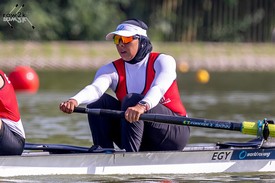Charlotte Hollings, Calm Waters Rowing

It's never too early to start planning. As the prospect of getting back on the water nears, start thinking about goals for 2018. Hopefully you've had a good winter training period and now you're ready to see results. What better opportunity to test yourself than at the 2018 World Rowing Masters Regatta September 27- 30 in Sarasota, Florida. It's a fantastic course and it's not often that you get a chance to race against competitors from all over the world without leaving the US. For such a big event, you want to make sure you're well-prepared, so as I said before, it's never too early to start planning.
In 1000 meter races, there's little room for error. You'll need a good start, good efficiency at higher rates (quick and clean) and a cardiovascular system trained for this distance. While I don't recommend jumping right into short, high rate pieces as soon as you're back on the water, you can start throwing high(er) 10's and starts on the fly into your steady state workouts.
To be effective at the higher rates, you must be clean at both ends of the stroke. At the finish, work on allowing the top part of the blade to come out of the water as you're finishing the drive. Then, just a millisecond before you feather, cut the pressure. This allows the pressure of the water to come off the face of the blade; then, before the water catches up to the backside of the blade, feather the blade over the water. You're basically creating a small pocket of air in which the blade can be extracted cleanly and effortlessly.

Now that the blade is out, don't sit around back there. As you feather, you already want to be moving towards the stern. Use your abs to draw the body forward along with the oar handle. Your body has a huge effect on boat speed; as your body moves to the stern, the boat will accelerate to the bow - every action has an equal and opposite reaction. Plus less time spent at the finish will automatically raise the stroke rate.
A simple stationary drill is to sit at the finish, blades squared and mostly buried. From here, use your thumb and fingers to roll the oar handle away from your body. If you're in a sculling boat, you may want to do it one oar at a time so you can watch the blade. You're looking for the top edge of the blade to immediately move towards the bow as the bottom edge of the blade comes out of the water. Your hands should be going down but at the same time away from the body. It's as if the hands are going down a slide; down and away. A common mistake is pulling down into the lap and washing out by feathering the last part of the drive. Work here to make the feather the beginning of the recovery.

As we move to the other end of the stroke, the focus is on making the catch the end of the recovery rather than the beginning of the drive. One way to help change your mindset is to get in the habit of always starting from the catch whenever the boat is at a dead stop; this is where the drive begins.
You want to be patient at the catch - the biggest mistake is to start driving before you have anything to drive against. If pressure comes on the foot stretchers before the blade is anchored, you will literally move the boat backwards. This is called check and it will slow you down. Reduce check and you increase your speed.
To help with this, establish your body angle by half slide, and from there don't think about reaching but rather compacting; let your thighs come to your chest. It will almost feel like you're hesitating between the catch and the drive but that's the idea, to separate the two. The goal is to be clean which will help you get the rating up more effectively.

Another stationary drill is to sit at the finish, blade(s) can be squared and buried if you want to work on your finish at the same time, or it can be flat on the water. Move from this position to the catch. Let the blade drop in, but that should be it - no pressure on the foot stretcher. Instead of thinking arms, body, slide, think body, slide, catch. The recovery wants to move directly to the catch in one smooth, fluid motion.
As for training the cardiovascular system, you've got time. For now, just work a few high strokes into your steady state and throw in some starts on the fly, but mostly work on cleaning up your stroke so that attaining higher rates will get easier.
If you enjoy and rely on row2k, we need your help to be able to keep doing all this. Though row2k sometimes looks like a big, outside-funded operation, it mainly runs on enthusiasm and grit. Help us keep it coming, thank you! Learn more.
Comments | Log in to comment |
- Bont Rowing
- Calm Waters Rowing
- Concept 2
- Craftsbury Sculling
- The Crew Classic
- CrewLAB
- Croker
- Durham Boat Co.
- Empacher
- Faster Masters
- Filippi
- Fluidesign
- h2row.net
- HUDSON
- Live2Row Studios
- Nielsen-Kellerman
- Oak Ridge RA
- Peinert Boat Works
- Pocock Racing Shells
- Race1 USA
- RowKraft
- Rubini Jewelers
- Vespoli USA
- WinTech Racing
- Bont Rowing
- Calm Waters Rowing
- Concept 2
- Craftsbury Sculling
- The Crew Classic
- CrewLAB
- Croker
- Durham Boat Co.
- Empacher
- Faster Masters
- Filippi
- Fluidesign
- h2row.net
- HUDSON
- Live2Row Studios
- Nielsen-Kellerman
- Oak Ridge RA
- Peinert Boat Works
- Pocock Racing Shells
- Race1 USA
- RowKraft
- Rubini Jewelers
- Vespoli USA
- WinTech Racing


















03/15/2018 3:36:05 AM